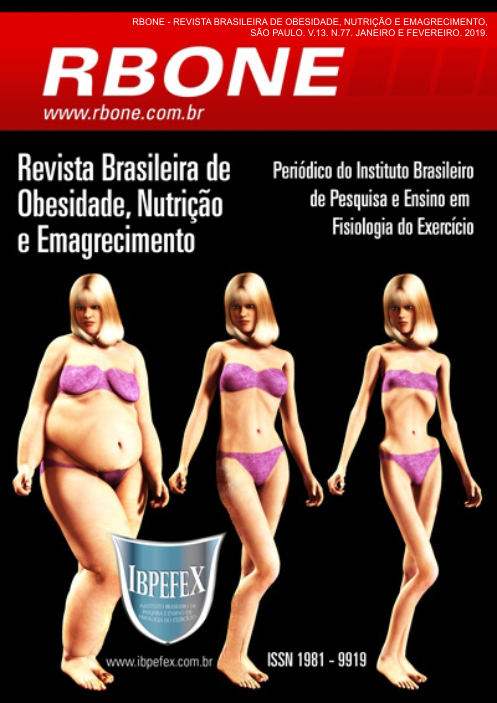Profile and nutritional status in hypertensive patients treated in an outpatient clinic of nutrition in Southern Brazil
Abstract
Introduction and objective: Changes in life style and multidisciplinary monitoring are necessary for the prevention and treatment of hypertension and the study aimed to evaluate the profile and the nutritional status of hypertensive patients treated in outpatient nutrition in southern Rio Grande do Sul, between 2007 and 2014. Materials and methods: Analysis of data from medical records of hypertensive patients aged < 18 years, for the first and last query in the period, to evaluate the percentage of variation in weight and the profile of the patients. Results: The majority of hypertensive patients evaluated were female (82.8%), is above the ideal weight (93%), is sedentary (57.8%) and lost weight (78.9%) during the treatment period evaluated. Discussion: Studies show that weight loss reduces signs and symptoms of hypertension and improves the quality of life in general and this weight reduction is very important, since obesity is a risk factor for the onset of chronic non-communicable diseases. Conclusion: The patients showed partial compliance with nutritional treatment, in addition to a high prevalence of physical inactivity and obesity. Because of the importance of healthy eating and regular physical exercises, it is necessary a follow-up of these patients in order to reduce the complications of this disease.
References
-Bombig, M.T.N.; Francisco, Y.A.; Machado, C.A. A importância do sal na origem da hipertensão. Revista Brasileira de Hipertensão. Vol. 21. Num. 2. 2014. p. 63-67.
-Callejon, K.S.; Colucci, P.A.C. Adesão ao tratamento nutricional por pacientes atendidos na clínica de nutrição docente-assistencial da Universidade Municipal de São Caetano do Sul. Revista Brasileira de Ciências da Saúde-USCS. Vol. 17. Num. 6. 2008. p. 3-8.
-Garcia, A.F.G.; Sobrinho, L.; Araújo, J.E.; Christian, J.; Menezes, V.A.; Cavalcanti, A.L. Tabagismo entre adolescentes de Vitória de Santo-Antão-PE. Arquivos de Ciências da Saúde. Vol. 15. Num. 4. 2008. p. 205-208.
-Gomes, F.; Telo, D.F.; Souza, H.P.; Nicolau, J.C.; Halpern, A.; Serrano-Júnior, C.V. Obesidade e doença arterial coronariana: papel da inflamação vascular. Arquivos Brasileiros de Cardiologia. Vol. 94. Num. 2. 2010. p. 273-279.
-Lima, T.M.; Meiners, M.M.M.A.; Soler, O. Perfil de adesão ao tratamento de pacientes hipertensos atendidos na Unidade Municipal de Saúde de Fátima, em Belém, Pará, Amazônia, Brasil. Revista Pan-Amazônica de Saúde. Vol. 1. Num. 2. 2010. p. 113-120.
-Lipschitz, D.A. Screening for nutritional status in the elderly. Primary Care. Philadelphia. Vol. 21. Num. 1. 1994. p. 55-67.
-Ministério da Saúde. Secretaria de Atenção à Saúde. Departamento de Atenção Básica. Hipertensão arterial sistêmica para o Sistema Único de Saúde. Brasília. 2006.
-Muraro, A.P.; Santos, D.F.; Rodrigues, P.R.M.; Braga, J.U. Fatores associados à Hipertensão Arterial Sistêmica autorreferida segundo VIGITEL nas 26 capitais brasileiras e no Distrito Federal em 2008. Ciências e Saúde coletiva. Vol. 18. Num. 5. 2012. p. 1387-1398.
-Organização Mundial de Saúde -OMS. Expert Committee. Classificação de Índice de Massa Corporal -IMC. Geneva. 2007.
-Organização Mundial da Saúde -OMS. Expert Committee. Dia mundial da hipertensão. Geneva. 2016.
-Organização Pan-Americana da Saúde-OPAS. Linhas de cuidado: Hipertensão Arterial e Diabetes mellitus. Brasília. p. 232. 2010.
-Pinho L.; Santana, B.C.; Lopes, V.B.; Monteiro, E.L.F.; Caldeira, A.P. Percepções de hipertensos sobre o acompanhamento nutricional recebido em um Núcleo de Apoio à Saúde da Família (NASF). Motricidade. Vol. 8. Num. 2. 2012. p. 58-66.
-Ruas, G.; Couto, V.F.; Pegorari, M.S.; Ohara, D.G.; Jamami, L.K.; Jamami, M. Avaliação respiratória, capacidade funcional e comorbidade em indivíduos com hipertensão arterial. Saúde Coletiva. Vol. 1. Num.1. 2013. p. 31-36.
-Safar, M.E. Ish pre-1 reduction of cardiovascular mortality in hypertensives with comorbidities: beyond blood pressure lowering -the role of arterial aging. Journal of Hypertens. Vol. 34. Num. 1. 2016. p. 384.
-Serafim, T.S.; Jesus, E.S.; Pierim, A.M.G. Influência do conhecimento sobre o estilo de vida saudável no controle de pessoas hipertensas. Acta Paulista de Enfermagem. Vol. 23. Num. 5. 2010. p. 658-664.
-Sociedade Brasileira de Hipertensão. Etiologia da Hipertensão Arterial. São Paulo. 2017.
Authors who publish in this journal agree to the following terms:
- Authors retain the copyright and grant the journal the right of first publication, with work simultaneously licensed under the Creative Commons Attribution License BY-NC which allows the sharing of the work with acknowledgment of the authorship of the work and initial publication in this journal.
- Authors are authorized to enter into additional contracts separately for non-exclusive distribution of the version of the work published in this journal (eg, publishing in institutional repository or book chapter), with acknowledgment of authorship and initial publication in this journal.
- Authors are allowed and encouraged to post and distribute their work online (eg, in institutional repositories or on their personal page) at any point before or during the editorial process, as this can bring about productive change as well as increase impact and impact. citation of published work (See The Effect of Free Access).






